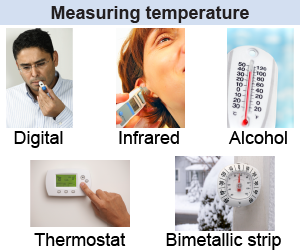|
In physics, the concepts of hot and cold do not refer to heat, but instead they describe temperature. Hot means higher temperature and cold means lower temperature. The cause of temperature and the relationship between temperature and heat remained mysteries for thousands of years. In 1905, Albert Einstein derived the compelling connection between atoms and temperature—one of his many discoveries that year—proving the existence of atoms. This section explains the meaning of temperature and its connection to thermal energy and heat. 
|
Temperature and thermometers
|
 Humans and most other animals have some sense of temperature as part of the sense of touch. Our temperature sense is not very accurate, however, so for more quantitative purposes temperature is measured with a thermometer. Many properties of matter change with temperature and many different kinds of thermometers have been invented, such as alcohol oral thermometers and infrared ear thermometers. Many technologies, such as thermostats, include a temperature sensor, which is the measuring part of an electronic or digital thermometer.
Humans and most other animals have some sense of temperature as part of the sense of touch. Our temperature sense is not very accurate, however, so for more quantitative purposes temperature is measured with a thermometer. Many properties of matter change with temperature and many different kinds of thermometers have been invented, such as alcohol oral thermometers and infrared ear thermometers. Many technologies, such as thermostats, include a temperature sensor, which is the measuring part of an electronic or digital thermometer. 
|
 If you use a powerful microscope to observe a tiny speck of pollen floating in water, then you observe the pollen speck to move constantly in a jerky, irregular way. This motion mystified Irish botanist Robert Brown in 1827, and it remained unexplained for the next 85 years. Several questions defied conventional explanation:
If you use a powerful microscope to observe a tiny speck of pollen floating in water, then you observe the pollen speck to move constantly in a jerky, irregular way. This motion mystified Irish botanist Robert Brown in 1827, and it remained unexplained for the next 85 years. Several questions defied conventional explanation: - Why doesn’t a pollen speck remain still in calm water?
- Why does it jump about?
- Where does the energy of motion come from?

|
Brownian motion was explained by Einstein in 1905 when he proposed that matter on the atomic level is constantly in agitated motion. Brownian motion occurs because a pollen speck is so small that individual collisions with water molecules are evident. - Individual atoms and molecules are never at rest but are constantly agitating about and bumping into each other trillions of times per second.
- There is a kinetic energy associated with the random microscopic motion of atoms and molecules, and this kinetic energy is what temperature measures. Higher temperature means that the individual atoms in matter are moving about on the microscopic scale with more kinetic energy.

|
| Temperature measures the average kinetic energy in random motion of atoms and molecules. | The meaning of temperature
|
|
|
|
If you could see individual atoms in the solid matter around you, which best describes what you would observe? - particles close together and staying relatively motionless, each in their place
- particles close together and staying in the same average place but jostling vigorously up, down, back, and forth
- particles far apart and moving randomly away from each other
 |
b is correct. 
|

